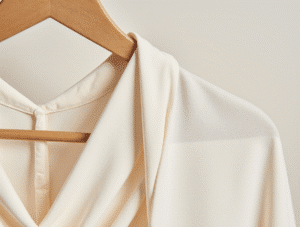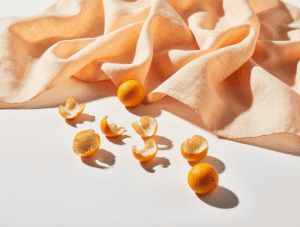Fabrics of the future are not science fiction. They are already here. We are witnessing a new wave of sustainable, high‑performance materials that are reshaping the fashion industry. These materials are not only innovative in their design but also mindful of the environment. They show us that comfort, beauty, and sustainability can go hand in hand.

A Personal Touch: Softness in Everyday Wear
I own a single tank top made of Tencel (lyocell). The fabric feels unbelievably soft and smooth. It lies gently against my skin. I love how cool and silky it feels. It is easy to wear all day. This garment shows that fabrics of the future can also feel luxurious now.
What Makes Tencel (Lyocell) Special?
Tencel is a branded form of lyocell, a fiber derived from wood pulp. Unlike rayon, its production uses N‑methylmorpholine N‑oxide (NMMO) in a closed‑loop system. The system recovers over 99 % of the solvent, drastically reducing waste and toxic emissions (Wired).
It also avoids harsh chemicals like carbon disulfide, which are used in conventional viscose and harmful to both workers and the environment. Compared to cotton, lyocell uses much less water and energy. Some studies estimate about 40 % less non‑renewable energy consumption than cotton (The Commons). It also biodegrades quickly—roughly 75 % within 60 days, and fully within 16 weeks under optimal conditions (Bergstrand).
Lyocell’s moisture‑wicking and breathability make it ideal for activewear and bedding. Research in the Journal of Applied Polymer Science confirms its excellent moisture management. Other studies note its durability and resistance to pilling.

Modal: A Softer Alternative
Another cellulose‑based fiber is modal. It comes from beech trees and shares many properties with Tencel. Modal is lightweight, breathable, and very soft. It drapes beautifully, which makes it popular for underwear and loungewear. Production can also be sustainable when using closed‑loop processes. While it has been around longer than Tencel, its role in the sustainable fashion movement is growing.
Bamboo Fabrics: Promise and Challenge
Bamboo is one of the fastest‑growing plants in the world. It requires little water, no pesticides, and grows on marginal land. Fabrics labeled as “bamboo” are often praised for their softness and antibacterial qualities. However, the process matters. Many bamboo fabrics are actually bamboo viscose, produced with harsh chemicals. More advanced mechanical processing methods are safer but still less common. This duality makes bamboo both promising and problematic.
Hemp: An Ancient Fiber With a Future
Hemp is not new. It is one of the oldest fibers known to humanity. Yet today, it is celebrated as a modern eco‑champion. Hemp requires little water, grows quickly, and needs no pesticides. It enriches soil health rather than depleting it. The resulting fabric is durable, breathable, and naturally resistant to mold and bacteria. In the past, hemp was considered rough, but new processing techniques have made it softer and more versatile. Designers are using it for jeans, dresses, and even luxury apparel.
Organic Cotton: Cleaner, But Not Perfect
Cotton has a long history in fashion, but conventional cotton consumes enormous amounts of water and relies heavily on pesticides. Organic cotton eliminates toxic chemicals, improves soil health, and benefits farmers. However, it still requires significant water use. While better than traditional cotton, it is not the ultimate answer. Still, it plays an important role in the transition to cleaner fashion.
Recycled Fabrics: Giving Waste a Second Life
A key theme in Fabrics of the Future is circularity. Instead of creating waste, these fabrics reuse it.
- ECONYL® is regenerated nylon, made from discarded fishing nets, carpets, and plastic waste. It is popular for swimwear and sportswear.
- Recycled Polyester (rPET) comes from plastic bottles. This process reduces dependence on virgin petroleum and diverts waste from landfills.
- Recycled cotton and wool are also on the rise, allowing old garments to be reborn as new fibers.
These materials are not flawless. Recycling processes can consume energy, and some fabrics lose quality after multiple recycling cycles. Still, they are a major step toward a circular fashion economy.
Fruit and Plant Innovations: Leather Alternatives
One of the most fascinating areas is bio‑based leather substitutes:
- Piñatex: Made from pineapple leaf fibers, it offers a strong and flexible alternative to leather.
- AppleSkin: Uses apple peels and cores, byproducts of the juice industry, to create vegan leather.
- Mylo: A material grown from mycelium, the root system of mushrooms. It looks and feels like leather but decomposes naturally.
- Orange Fiber: A silky textile spun from orange peels, bringing food waste into fashion.
- Bananatex®: Developed from banana plant fibers, it is durable, biodegradable, and already used in sustainable backpacks and accessories.

These alternatives not only replace animal leather but also recycle agricultural waste.
Algae and Seaweed Fibers
Scientists are now creating fabrics from marine plants. SeaCell is one such fiber, made from seaweed mixed with cellulose. It is soft, breathable, and even contains trace minerals beneficial for skin. The idea of wearing algae may sound futuristic, but it is already being used in activewear and wellness clothing.
High‑Tech Enhancements: Smarter Fabrics
Not all innovation is about raw materials. Some fabrics are engineered to perform better:
- Dropel uses nanotechnology to make cotton stain‑ and water‑resistant without synthetic blends.
- Antibacterial lyocell incorporates natural or engineered treatments to resist odor and bacteria.
- Moisture‑sensing fibers are being developed for sports and health monitoring.
These technologies extend fabric life and add new functions, while keeping sustainability in mind.
Why These Innovations Matter
The fashion industry is responsible for significant environmental impact. Fiber production accounts for 38 % of the industry’s emissions. Textile production adds another 29 % (Haus von Eden). Switching to better fabrics is not just desirable, it is essential.
By choosing Tencel, hemp, recycled polyester, or bio‑leathers, brands and consumers can drastically cut their footprint. Some of these fabrics also improve worker safety, since their production avoids harmful chemicals. Others, like hemp, even help restore ecosystems.
The Consumer’s Role
As a consumer, I have noticed how different it feels to wear sustainable fabrics. My Tencel tank top is proof that eco‑friendly choices do not mean sacrificing comfort. Each purchase becomes a small vote for change. When brands see demand, they invest more in research and innovation. Collective action shapes markets.
Simple steps can help:
- Look for certification labels like OEKO‑TEX, GOTS, or FSC.
- Choose recycled fibers when possible.
- Support brands experimenting with new eco‑materials.
- Buy less, but better.

Looking Ahead
The future of fabrics is not just about replacing cotton or polyester. It is about rethinking the system. Imagine wardrobes where every fiber is biodegradable, recyclable, or both. Picture clothes grown from mushrooms or spun from food waste. Some of these exist today; others are in laboratories. But all of them push us closer to a world where fashion aligns with nature.
Conclusion: A Future We Can Touch Now
Fabrics of the Future are soft, clean, and smarter. My Tencel tank top is everyday proof. It feels great, and it is made in a cleaner way. Leading research supports its eco‑credentials and shows it as a high‑performance fiber.
Beyond lyocell, recycled fibers, bio‑leathers, seaweed fabrics, and nano‑enhanced cotton are all part of the picture. Together, they redefine what sustainable fashion can be.
We now wear the future every day. The gentle touch of advanced fibers can change how we dress and how we treat our planet. Fabrics of the future are here—and they feel amazing.
A Guide to Choosing Vegan Shoes and Accessories: Ethical, Sustainable, and Stylish
Vegan Fashion: How to Dress Stylishly and Sustainably? – Brands and Materials Replacing Leather, Fur, and Silk

I’m Victoria, the creator behind Eva My Balance. Passionate about beauty, wellness, sustainable living, and mindful self-care. My mission is to inspire you to live consciously and beautifully—inside and out.


